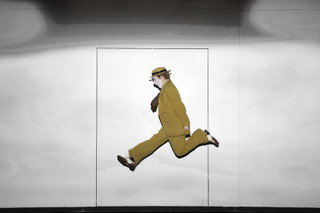|
Back
Silence is Golden Los Angeles
Dorothy Chandler Pavilion
11/16/2019 - & November 21, 23*, December 1, 12, 15, 2019
Wolfgang Amadeus Mozart: Die Zauberflöte, K. 620
Zuzana Marková (Pamina), Bogdan Volkov*/Joshua Wheeker (Tamino), Theo Hoffmann (Papageno), So Young Park/Jeni Houser* (Queen of the Night), Ildebrando D’Arcangelo (Sarastro), Sarah Vautour (Papagena), Frederick Ballentine (Monostatos), Erica Petrocelli (first lady), Vivien Shotwell (second lady), Taylor Raven (third lady), Michael J. Hawk (speaker), Robert Stahley (first armored man), Steve Pence (second armored man), David Kukak (first spirit), Thomas Quinn Fagan (second spirit), Anika Erickson (third spirit)
Los Angeles Opera Chorus and Orchestra, Grant Gershon (chorus master), Roberto Cani (concertmaster), James Conlon*/Grant Gershon (conductor)
Suzanne Andrade and Barrie Kosky (co-creators), (Paul Barritt (animation), 1927 (Suzanne Andrade and Paul Barritt) and Barrie Kosky (animation designer), Tobias Ribitzki (associate stage director), Esther Bialas (set and costume designer)

T. Hoffmann (© Cory Weaver)
Fresh off the stage and with a facelift of the perennial heart-wrenched favorite, La bohème, Komische Oper’s Intendent Barrie Kosky has made so many waves on so many fronts that he’s turned operatic theater upside down. That’s a good thing: by readdressing the status quo, his avant-garde perspective promotes discussion and stretches limits. More to the point, Los Angeles Opera (LAO) has a revisit by M. Kosky after this production landed on stage in 2013
and 2016, adding to the impressive statistics of over 350,000 viewers spanning four continents.
Prior to Kosky, we had (and still have) Julie Taymor’s more geometrical outlook, and even a children’s adaptation running as recently as in July of this year. The current, trendy Die Zauberflöte is undeniably the “grand experiment of the 21st century”, politely though daringly integrating silent film into the mix. While the medium relies on animation to ‘connect’, it manages more flatness and less opacity; therefore, the dimension rests more upon cinema rather than the principal. Thus, focus on singers’ voices becomes the ‘weight of measurement’ since electronics take over without subjectivity. Dialogue possesses a lockdown “Papageno effect”, instead being replaced by visual text with suffusions from Peter Walsh on pianoforte and extractions from the Fantasia n° 3 in D minor and Fantasia in C minor...the effect is brilliant, mood-appropriate and comme il faut.
Both debuting at LAO, Zuzana Marková and Bogdan Volkov brought firmness to the stage with respectable levelness that added to the Andrade/Barritt idea of dreams and nightmares. Theo Hoffmann’s Papageno gave a wider berth of antics paralleling those of Buster Keaton with light-sided entertainment. Unfortunately, So Young Park was indisposed for this performance which gave Wisconsin-native Jeni Houser the opportunity to elicit her evilness as the Queen of the Night. The voice was powdery and pristine and filled with razor-thin accuracy, even though she held on to a conservative backdraft…ultimately, she became one of the evening’s most prodigious talents.
After his first performance in 2011 as Guglielmo in Così fan tutte, Ildebrando D’Arcangelo’s expansive bass vibrancy shook with resolute authority and kindness as Sarastro. Another standout was that of trio Erica Petrocelli, Vivien Shotwell and Taylor Raven who wove through Mozart’s music with extreme confidence and auspicious acting. On a very frivolous side, Sarah Vautour sexily skated through Papagena with Hoffmann’s Papageno in an unblemished “Pa-Pa-Pa.” The consortium of three spirits, celestially anchored by David Kaku, Thomas Quinn Fagan and Anika Erickson, had superb blending of voices, but the projection was far too weak. Sarastro's armored men (dressed with formalized Edwardian top hats), Robert Stahley and Steve Pence made strong statements about Tamino’s final test.
In today’s world of iPhones and high tech gadgetry, society’s continual need for stimulation seems to be the norm and the rule of order. Detailed by Masonic symbols and steam-punk illustrations along with flora and fauna outlines (even zodiac/astrological signs) of the early 20th century, the single vertical stage plane (replete with a series of swiveling panels) was forever occupied by movement, keeping the viewer in a perpetual state of engagement. And while James Conlon’s direction was sublime and neat-as-a-pin, the music shifted into an ancillary mode amidst all of the hullabaloo.
In a time when opera is in a state of flux and there's a search for future audiences, M. Kosky’s Die Zauberflöte bodes well for Los Angeles and beyond by inculcating such innovative magic. The visual treats are limitless...this pre-Christmas gift delight will enthrall youngsters, but it will also re-kindle mature audiences with nostalgia.
Christie Grimstad
|